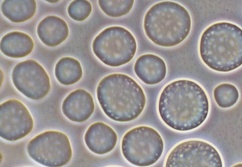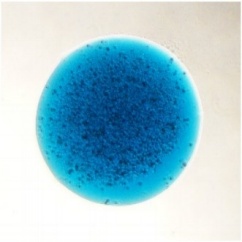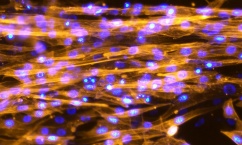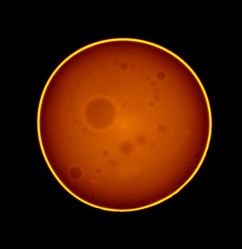John P. Frampton
Associate Professor

Email: john.frampton@dal.ca
Phone: 902-494-4175
Mailing Address:
Life Science Research Institute (LSRI)
PO BOX 15000
Halifax, Nova Scotia, Canada B3H 0A8
Education
- PhD, State University of New York at Albany
Academic Positions
- Department member since 2020
- Canada Research Chair (Tier II) in Cellular, Biomaterial and Matrix Interaction
Research Topics:
My lab works at the intersection of materials science, cell biology and clinical research to design next-generation technologies for: (1) understanding fundamental cellular and molecular processes; (2) understanding disease mechanisms and improving diagnosis; and (3) developing cell-based and biomaterial-based interventions and technologies. The tools we develop are applied to understanding the physiology of the lung, nervous system and a variety of other organ systems, as well as for treatment of traumatic injuries to the soft tissues of the body.
Research
My laboratory develops new technologies and approaches for microscale tissue engineering with an emphasis on neural tissues. The laboratory is also actively involved in the development of microtechnologies for user-friendly, cost-effective in vitro assays and analysis systems for cells and biomolecules. We take an integrative approach to science. Trainees at all career stages who are interested in multidisciplinary technology-driven research are encouraged to contact John Frampton or visit the lab website for more information.
Current Projects
Cell-based Assembly of Tissue Constructs: Tissue-engineered constructs that are inexpensive, customizable, easily/rapidly fabricated, and made from accessible materials are required to improve in vitro organ models and clinical tissue replacement therapies. To provide these capabilities, we are researching and characterizing a variety of new systems for rapidly fabricating tissue-engineered constructs based on interfacial assembly in aqueous polymer solutions.
Dynamic Modulation of Cell-Laden Hydrogels: The use of cells and materials that are engineered to respond to environmental factors provides the opportunity to incorporate dynamic tuning in tissue-engineered constructs to mitigate undesirable microenvironmental factors and promote integration with surrounding tissue. We are developing hydrogel systems and genetically modified cells that can be easily modulated by external stimuli (e.g., temperatutre, magnetic fields, ultrasound, or biochemical factors) for use as next-generation tissue engineering materials.
Aqueous Two-Phase Systems and Related Technologies: Aqueous two-phase systems (ATPSs) form when solutions of two incompatible polymers are mixed together at high enough concentrations. These system have traditionally been used for biomolecule and bioparticle separation from crude mixtures. We are exploring additional applications for these interesting polymer systems in biopatterned cell based assays and high throughput biomolecular assays.
Microtechnologies for Molecular Analysis and Diagnostics: ATPS biopatterning and other microscale technologies will be used to develop various tools for research applications, as well as for use in robust clinical diagnostic platforms with potential for point of care applications.
Publications
A complete publication list is available on the Frampton Lab publications page.
- Baker, L.A., Xu, L., Badichi Akher, F., Robertson, M.K., Pugsley-DeBruyn, L., Ma, C.X., Liu, X-Q., Frampton, J.P., and Rainey, J.K. (2022) Nerve growth factor-binding engineered silk films promote neuronal attachment and neurite outgrowth. Advanced Functional Materials. In press. [Article]
- Verma, S.K., Yaghoobi, H., Slaine, P., Baldwin, S.K., Rainey, J.K., Kreplak, L., and Frampton, J.P. (2022) Multi-pin contact drawing enables production of anisotropic collagen fiber substrates for alignment of fibroblasts and monocytes. Colloids Surf B. In press. [Article]
- Tam, N.W., Chung, D., Baldwin, S.J., Simmons, J.R., Xu, L., Rainey, J.K., Dellaire, G., and Frampton, J.P. (2020) Material properties of disulfide-crosslinked hyaluronic acid hydrogels influence prostate cancer cell growth and metabolism. J. Mater. Chem. B. 8: 9718-9733. [PubMed] [Article]
- Teixeira AG, Kleinman A, Agarwal R, Tam NW, Frampton JP. (2019) Confinement of suspension-cultured cells in polyethylene glycol/polyethylene oxide-albumin aqueous two-phase systems. Frontiers in Chemistry. 7:441 [Article]
- Agarwal R, Liu G, Tam NW, Gratzer PF, Frampton JP. (2019) Precision cell delivery in biphasic polymer systems enhances growth of keratinocytes in culture and promotes their attachment on acellular dermal matrices. Journal of Tissue Engineering and Regnerative Medicine. 13:6 [Article]
- Ko KR, Tsai MC, Frampton JP. (2018) Fabrication of thin-layer matrigel-based constructs for three-dimensional cell culture. Biotechnology Progress. 35:1 [Article]
- Teixeira AG, Agarwal R, Ko KR, Grant-Burt J, Leung BM, Frampton JP. (2017) Emerging biotechnology applications of aqueous two-phase systems. Advanced Healthcare Materials. 7:6 [Article]
- Liu GY, Agarwal R, Ko KR, Ruthven M, Sarhan HT, Frampton JP. (2017) Templated assembly of collagen fibers directs cell growth in 2D and 3D. Scientific Reports. 7:9628 [Article]
- Ruthven M, Ko KR, Agarwal R, Frampton JP. (2017) Microscopic evaluation of aqueous two-phase system emulsion characteristics enables rapid determination of critical polymer concentrations for solution micropatterning. Analyst. 142:1938 [Article]
- Ko KR, Frampton JP. (2016) Development in 3D neural cell culture models: the future of neurotherapeutics testing? Expert Review of Neurotherapeutics. 15:445-447 [Article]
- Frampton JP, Leung BM, Bingham EL, Lesher-Perez SC, Wang JD, Sarhan HT, El-Sayed MEH, Feinberg SE, Takayama S. (2015) Rapid self-assembly of macroscale tissue constructs at biphasic aqueous interfaces. Advanced Functional Materials. 25:11 [Article]
- Frampton JP, Lai D, Lounds M, Chung KW, Kim JS, Mansfield JF, Takayama S. (2014) Elongation of fibers from highly viscous dextran solutions enables fabrication of rapidly dissolving drug carrying fabrics. Advanced Healthcare Materials. 4:2 [Article]
- Frampton JP, White JB, Simon AB, Tsuei M, Paczesny S, Takayama S. (2014) Aqueous two-phase system patterning of detection antibody solutions for cross-reaction-free multiplex ELISA. Scientific Reports. 4:4878 [Article]
- Frampton JP*, Fan ZZ*, Simon A*, Chen, D, Deng CX, Takayama S. (2013) Aqueous two-phase system patterning of microbubbles: Localized induction of apoptosis in sonoporated cells. Advanced Functional Materials. 23:27 [Article]




